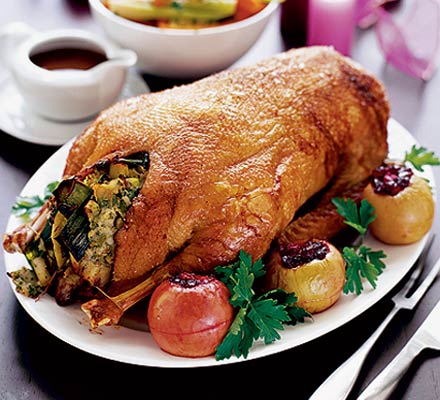- Preparation time
- 30 mins
- Cooking time
- 180 mins
- Difficulty
- Moderate
- Serves
- 6 people
- Meal course
- Main Course
- Posted by
- Posted on
- April 14, 2016
- 2 oz
- Butter
- 3 Lg.
- Onion - Yellow
- 1/2 lb
- Veal - Ground
- 10 Leaves
- Sage - Fresh
- 2 Cup
- Breadcrumbs - White
- 1 Lg.
- Eggs
- 1/4 Cup
- Slivered Almonds
- 1 Cup
- Milk
- 1 Whole
- Goose - Fresh (Approx 8-10lbs)
- 1 oz
- Butter
- 1 1/2 Tbsp
- Flour - All Purpose
- 1/2 Cup
- White Wine
- 2 Cup
- Broth - Chicken

Queen Elizabeth 1st was eating goose when she received news that the English had defeated the Spanish Armada. She immediately issued a royal decree that roast goose should henceforth be served on Michaelmas Day (September 29th) to commemorate this great British victory.
Roast Goose is wonderful served with Plum Sauce and Brussels Sprouts with Chestnuts.
You can replace the 10 sage leaves with 1 tsp. of dried sage if necessary.
- Preheat oven to 350°F
- Finely chop the onions
- Finely chop the sage leaves (or use 1tsp dried sage in their place)
- Make bread crumbs by running white bread through the blender
- PREPARE THE STUFFING:
- Melt the butter in a small frying pan, add the onions and saute until soft
- Mix all other stuffing ingredients together in a bowl, add the onions and season generously with salt and pepper. Set Aside.
- PREPARE THE GOOSE:
- Remove the giblets then rinse the goose inside and out under cold water and pat dry.
- Remove any fat from inside the goose
- Cut out the wishbone: This will make the breast meat easier to carve, and if there's enough neck skin left on the goose, it will also give you more room to stuff the neck cavity. With the breast side up, pull back the skin around the neck to reveal the bone. With a small sharp knife, cut around those parts of the wishbone that you can see on both sides. You don't have to cut too deeply: just enough so that you can slip a finger under the bone and pull it out
- Run a skewer between the bones of the ends of the wings and push a length of (non-plastic) twine through the holes, knotting them together as tightly as possible
- When this is done, season the inside of the body cavity of the goose with salt and pepper: then fill with your stuffing. As with a turkey or chicken, don't pack down the stuffing or overfill the body cavity.
- When stuffed, sew the body cavity closed with more twine. The simplest way is to pierce the skin on both sides with a skewer and push the twine through, knotting each pair of skewer-holes together with the twine. If you like, and if the legs seem at all loose, tie them together with twine behind the body as well.
- Pierce the skin lightly with a sharp fork: The idea is to pierce the skin without piercing the flesh underneath, so that the meat's moisture won't have a chance to escape at the same time the fat does. When doing the piercing, don't omit the legs: the skin there won't get crisp if you forget them. Also, make sure that the sides of the goose underneath the legs and wings get their share of the piercing.
- Place the goose on a rack in a large roasting pan
- Rub the goose with the butter and half a tablespoon of the flour then season well with salt and pepper
- Pour the wine into the pan and roast the goose for 1hr, basting every 15 minutes.
- After 1hr, pour out 3/4 of the fat that has accumulated in the pan (Keep it for later use; this is the purest of all frying fats)
- Re-prick the skin and return the goose to the oven for another hour (or 90 minutes if it weighs over 9lb)
- Transfer the cooked bird to a serving dish
- Remove all the fat in the pan but leave the juices.
- Mix in the remaining flour to make a roux over low heat then add the chicken broth to make gravy.
